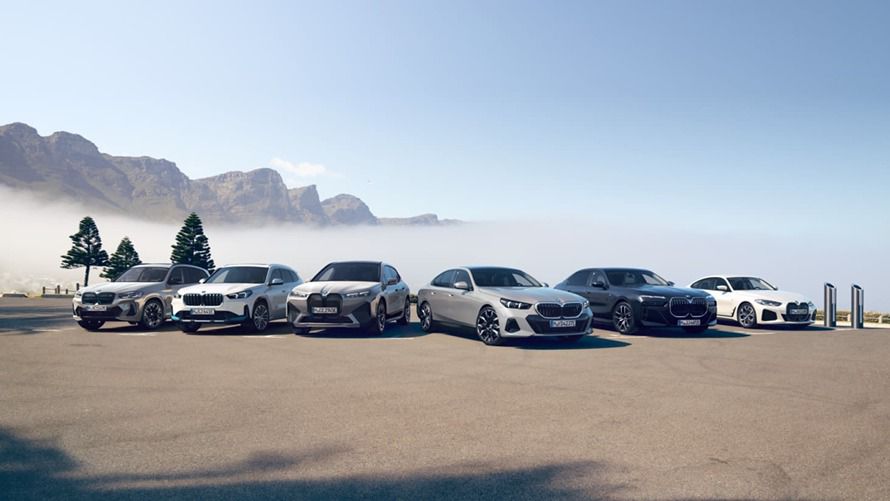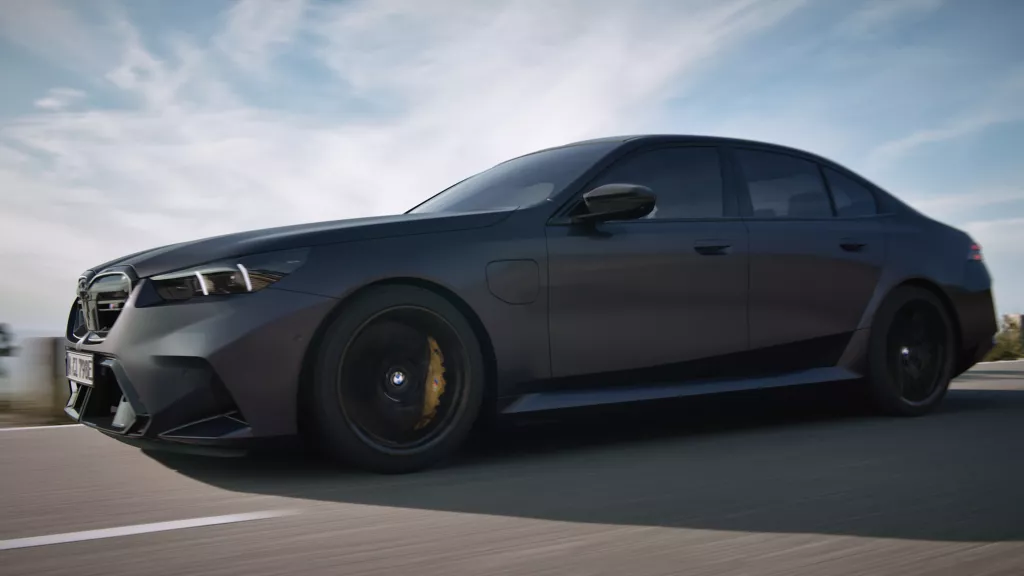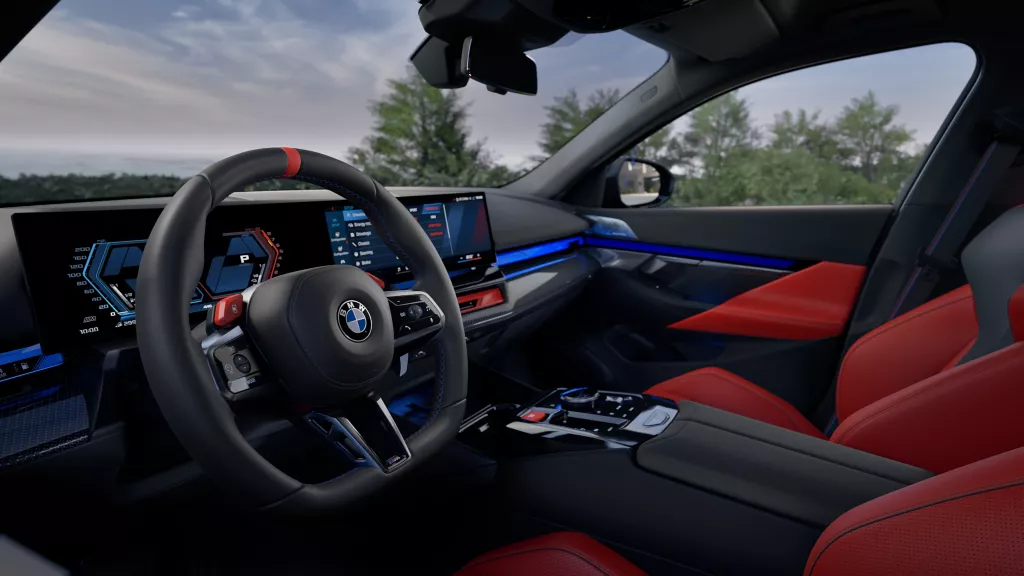BMW M5 Sedan [1][2][3]: Fuel consumption, combined WLTP in l/100 km: 1.7–1.6; CO2 emissions, combined WLTP in g/km: 39–37; Energy consumption, combined WLTP in kWh/100 km: 25.5–25; Electric range, WLTP in km: 67
[1] Range depends on various factors, in particular: individual driving style, route characteristics, outside temperature, heating/air conditioning, pre-conditioning.
[2] For plug-in hybrid: Weighted, combined (EC AC Charge Weighted)
[3] Provisional figures; any missing figures were unavailable at the time of publication.
Driving pleasure. To the core.
Compromises? You will look in vain here. The BMW M5 Sedan with M xDrive will cast its spell over you when it starts, if not before. Discover this high-performance sports car, its equipment options and technical data, plus numerous leasing and financing options.
Variants and technical data.
- M Models

- Fully electric
- Plug-in hybrid
Power[3] [4] [5] | 535 kW (727 hp) |
|---|---|
0-100 km/h[3] | 3.5 s |
Vmax[3] | 305 km/h |
Electr. Range[1] [3] | 67 km |
BMW M5 Sedan [1] [2] [3]: Fuel consumption, combined WLTP in l/100 km: 1.7–1.6; CO2 emissions, combined WLTP in g/km: 39–37; Energy consumption, combined WLTP in kWh/100 km: 25.5–25; Electric range, WLTP in km: 67
[1] Range depends on various factors, in particular: individual driving style, route characteristics, outside temperature, heating/air conditioning, pre-conditioning.
[2] For plug-in hybrid: Weighted, combined (EC AC Charge Weighted)
[3] Provisional figures; any missing figures were unavailable at the time of publication.
[4] Composed of combustion engine drive {techdata.overboostMax} kW / 750 Nm and electric drive up to {techdata.overboostKW} kW / 280 Nm. Electric drive depending on battery charging level.
BMW M5 Sedan [1] [2] [3]: Fuel consumption, combined WLTP in l/100 km: 1.7–1.6; CO2 emissions, combined WLTP in g/km: 39–37; Energy consumption, combined WLTP in kWh/100 km: 25.5–25; Electric range, WLTP in km: 67
[1] Range depends on various factors, in particular: individual driving style, route characteristics, outside temperature, heating/air conditioning, pre-conditioning.
[2] For plug-in hybrid: Weighted, combined (EC AC Charge Weighted)
[3] Provisional figures; any missing figures were unavailable at the time of publication.
Your BMW M5 Sedan.
Performance.
For unadulterated joy. M Hybrid.
Its M Hybrid powertrain with high-performance M TwinPower Turbo V8-cylinder petrol engine and electric drive thrusts you into the back of your seat with an impressive system power of 535 kW (727 hp) [3][4][5]. Its torque of up to 1,000 Nm[3][4][5] is dynamically distributed by the M xDrive to all four wheels
Exterior Design.
Unmistakable even in the dark.
Highlight features include the completely reinterpreted design of the BMW kidney Iconic Glow with contour line lighting, the new double light signature of the front headlights, and the dynamic M-specific Welcome Light Carpet.
A material that wows you visually as well.
The M Carbon exterior package lends your BMW M an even sportier look. The roof, exterior mirror caps and rear spoiler are made of lightweight and robust carbon fibre.
Interior Design.
A perfect fit.
From the individual backrest width to seat heating. Both M multifunction seats can be adjusted in many ways for optimum support and comfort.
Digital highlights.
Electric driving pleasure.
Charge. However and wherever you want.
Intelligently by your Side.

Your BMW M5 Sedan.
Enrich your individual lease or loan product with attractive services and insurance in one package.
All in. Simply smart. BMW Financial Services
Frequently asked questions on the BMW M5 Sedan.
You may also like.
Fuel consumption and CO2 emissions.
BMW M5 Sedan [1] [2] [3]: Fuel consumption, combined WLTP in l/100 km: 1.7–1.6; CO2 emissions, combined WLTP in g/km: 39–37; Energy consumption, combined WLTP in kWh/100 km: 25.5–25; Electric range, WLTP in km: 67
[1] Range depends on various factors, in particular: individual driving style, route characteristics, outside temperature, heating/air conditioning, pre-conditioning.
[2] For plug-in hybrid: Weighted, combined (EC AC Charge Weighted)
[3] Provisional figures; any missing figures were unavailable at the time of publication.
[4] Composed of combustion engine drive {techdata.overboostMax} kW / 750 Nm and electric drive up to {techdata.overboostKW} kW / 280 Nm. Electric drive depending on battery charging level.
[5] For plug-in hybrid: Electric drive depending on battery charging level.
[6] Material-specific properties can cause increased function-related noises when braking, e.g. after longer periods of light braking or just before coming to a stop in wet conditions. The influence of road salt or wetness, e.g. after using car washes, overnight condensation, driving in the rain, etc., can cause the braking effect to be similar to that of a conventional brake system. This reduced braking effect can be compensated for with greater pedal pressure.
[7] For plug-in hybrid: At temperatures below freezing, the fully electric drive system is only available after a few kilometres of driving, once the battery has heated to operational temperature.
The values of fuel consumptions, CO2 emissions and energy consumptions shown were determined according to the European Regulation (EC) 715/2007 in the version applicable at the time of type approval. The figures refer to a vehicle with basic configuration in Germany and the range shown considers optional equipment and the different size of wheels and tires available on the selected model.
The CO2 efficiency specifications are determined according to Directive 1999/94/EC and the European Regulation in its current version applicable. The values shown are based on the fuel consumption, CO2 values and energy consumptions according to the NEDC cycle for the classification.
When charging times are shown they can be affected by a number of factors such as type of charger, voltage supplied to the charger/car and type of current (AC or DC) supplied to the charger/car. The car also plays a role in charging times as it can be set by the driver to accept various different amperage and should preconditioning be used to heat or cool the vehicle while charging this will also affect the charging time.
The basis for the calculation of the charging times for 100 km range is the electric consumption of the vehicle based on the use of a high-Powered Charging station (HPC) or charging type and current as indicted in the literature above. The testing procedure measures are based on a 23 degrees Celsius battery start and ambient temperature with certification values excluding additional auxiliary consuming devices and systems within the vehicle such as seat heating, displays, air conditioning.
Individual consumption (fuel economy) may differ due to driving profile, vehicle load profile, auxiliary consumer usage, temperature, and ambient conditions. Consumption is based on WLTP or NEDC (whichever is indicated) best case conditions and is independently tested for BMW Group. If you are comparing this range with other models or brands make sure they are stating the same WLTP or NEDC testing regime. These results can be used to compare vehicles on a close to “like for like” basis but are unlikely to be achieved in real world conditions for reasons including temperature variation, driving conditions and the use of the auxiliary systems referred to above.
Information provided and images displayed on this site include overseas models and may show some features not available in New Zealand. Please contact an authorised BMW dealer for specific information on vehicles and features available in New Zealand. Product changes may have been made since production of this content.

































